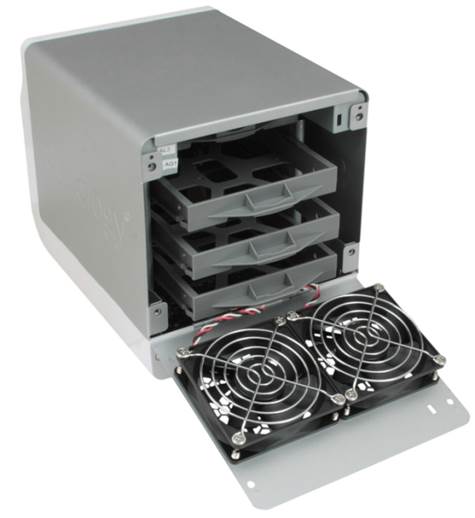Synology offers three models of the
4-bay network storage unit designed in traditional format and targets at
different market segments. They are DS413j, DS413 and DA412+. We plan to
introduce all of these three models to you in this review.
At the beginning of the year 2013, Synology
launched three models of 4-disk attached storage devices for different market
segments. DS413j is for families and users who are in SOHO group with its
platform, lacking of hot-swapping, and just two USB 2.0 ports for external
devices. Next comes the DS413 for working group, operating on a dual-core PPC
processor, allows replacing HDD hard-disk without shutting down the computer,
and provides eSATA interface and the USB 3.0 ports. The senior model DS412+ is
built based on Intel Atom, with the same case as the previous model, and offers
two Ethernet ports with teaming capacity. Beside all of those things, we also
pay much attention on the slim DS411, designed for 2.5-inch drives and launched
years ago.
Every product shares the same DSM firmware,
whose difference is only determined by the hardware specification. Beside the
mentioned ports above, these 4-bay NAS is various in processing and influencing
performances of factors like the number of web cameras, VPN connection, reserve
tasks, cloud service users…, supported simultaneously. You can drop by the
company’s official website and find details in a convenient table there.
Package and accessories
All of the devices are delivered in the
traditional cardboards of Synology, painted white for basis models and blue for
others. Because of the identical box design, there should be labels in order to
identify the particular model and other information about it (specifications,
accessories and main features).

The
package
The accessories are almost the same in
every case. Beside NAS, the box contains an external power adapter and wire,
one or two Ethernet cables, screw for HDD, a CD with software and data, and an
installation instruction. The adapter has an apt connector for the particular
area and a couple of reserve screws in the box.
Interestingly, each model uses a specific
external power adapter. On one hand, this helps reducing the noise and
improving the thermal inside the case, but on the other hand, it is
inconvenient in terms of packing up and connecting. However, different from the
CPUs, the adapter is 12 V and 100 W. It is the HDD drive that is mainly
responsible for the power consumption in each NAS, and the adapter chosen with
some reservations allows any fluctuations in CPU power demand.
Exterior design and hardware configuration
Synology
DS413j
This design was first introduced in 2006 when
sinology launched the CubeStation CS-406. The cooler was the only thing that
changed since then. Today, it consists of two fans instead of one. DS413j does
not support too fast HDD exchange.

The
front panel
The front panel is made of white glossy
plastic. A power button with the integrated indicator is located right in the
center on a gray insert on its top half. Above it, there are 6-LEDs, indicating
system, networking and HDD status. Half of the vent holes are not covered by
any dust filters, so you should clean the NAS regularly if you set them in a
dusty room. The bottom of the case is made of plastic, while the top and most
of the rear panel are made of silver-painted metal.

The
rear panel
There are girds of the 80 mm fan in the
rear panel. All of the connectors of NAS lay in the bottom: power connection,
two USB 2.0 ports and a Gigabit Ethernet port. A button for reinstalling is
also found here. NAS is 17x23x18.5 cm in size and stands on four rubber feet.

80mm
fan in the rear panel
To install HDD, unfasten the 4 screws which
fix the rear panel, flip it down and remove the top board. HDD is secured by a
plastic frame and then put into NAS. The frame is integrated with 3.5 inch
disks as well as the 2.5 inch.
The multifunctional backplane is used for
connections, more durable than the flexible cables used in the previous
versions of this case design. The design, generally, is quite practical except
that you have to unfasten too many screws. Fortunately, you do not have to do
it regularly.
The junior 4-bay NAS from Synology is based
on ARM platform but its configuration is not weak at all, compared to
contemporary standards. Marvell 88F6282 processor is overclocked at 1.6 GHz.
The system memory is represented by DDR3 SDRAM 510 megabytes. The OS is located
in the HDD, so the flash 8 MB chipset just stores a boot loader and firmware
installation modules. The SoC processor just contains two SATA ports, DS413j
features a traditional 4-port Marvell 88SX7042 panel. Gigabit Ethernet panel is
integrated in the CPU, so there is just one Marvell 89E1318 chip on the PCB. A
GL850G hub is used to increase the number of USB ports.